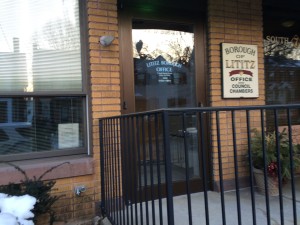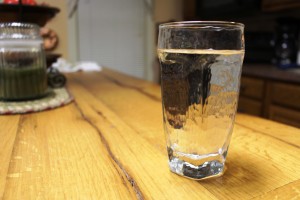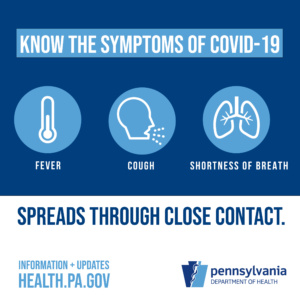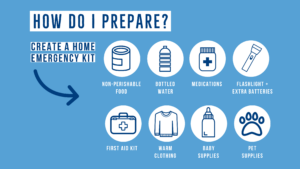State Investigates Lititz Borough, Severn Trent for Misleading Residents over Lead Levels
(Lititz, Pa)-Lititz Borough Water System and operator Severn Trent Environmental Services, Inc. are now under investigation by the Pennsylvania Department of Environmental Protection for failure to inform customers over a two-year period that tap water in some Lititz homes showed lead levels in excess of federal limits, an omission that Severn Trent claimed this week came about as the result of transposing data. One of the homes tested had a lead level of 428 parts per billion, more than 28 times the allowable limit for lead in drinking water. The DEP investigation was launched after the publication of our LititzDailyNews.com story on lead levels in Lititz water.
RELATED STORY: LEAD LEVEL OF 428ppb OMITTED FROM BOROUGH WATER REPORT
After a water sample from a residence on Front Street tested at 428 parts per billion (ppb) for lead in 2010 and another tested at 22 ppb, exceeding the federal allowable limit of 15 parts per billion for lead in drinking water, Lititz Borough and Severn Trent informed consumers in the 2011 and 2012 Annual Drinking Water Quality Report that “In 2010, no samples exceeded the action level. There was 100% compliance with the lead limits.”
“The Department was recently informed of this information discrepancy and it is still investigating,” said John Repetz, Community Relations Coordinator for the PA DEP South Central Regional Office. “The Department does not discuss ongoing investigations or potential ramifications,” said Repetz. Water providers that do not meet all federal and state reporting requirements to consumers may be cited and fined for violations.
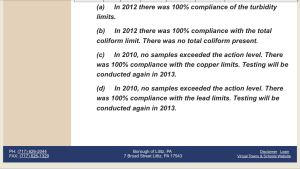
Detail from the 2012 Lititz Borough Water Quality Report, which stated that in 2010 no samples exceeded the Action Level (15 ppb). A lead level of 428 ppb was measured but not published. Screenshot from LititzBorough.org.
PADEP learned of the discrepancy after LititzDailyNews.com first published a story about lead levels in Lititz Borough drinking water on January 29. On February 2, 2016, Severn Trent notified PADEP of the omissions, according to Severn spokesperson Tracey Rotan.
On Monday, Severn Trent refused an interview request with LititzDailyNews.com, who had made a request for an on-camera interview with Lititz project manager Mike Wolgemuth. Severn Trent is a private company contracted to provide drinking water and waste water services to the borough.
Borough manager Sue Barry last week refused to answer specific questions about the data omission, deferring instead to Wolgemuth, who has not replied to an email sent on Monday. He will reportedly be in attendance at the Lititz Borough Council meeting this Tuesday night. The meeting will take place in Council Chambers at 7 S. Broad St., Lititz at 7 p.m.
“Severn Trent Environmental Services, Inc. believes that it made a mistake and transposed the data from the 2007 testing in the 2011 and 2012 CCRs instead of the 2010 testing results,” according to a statement provided by Severn Trent spokesperson Rotan in response to our request for an interview.
The maximum level of lead in Lititz Borough reported by Severn Trent to the public in 2012 was 9.8 ppb, and the same number was also published as the upper value of the range of lead found in borough tap water. The 428 ppb finding was omitted from three locations on the Annual Drinking Water Quality Report provided to Lititz Borough water consumers that year.
“The monitoring program has to be done in a very specific way to be meaningful and to actually meet the requirements of the rule.” – Water expert Yanna Lambrinidou,in an interview with LititzDailyNews.com
The result, which was reported to the state via an electronic system, should have appeared in annual notices to consumers for a three-year period as a sample that exceeded the action level, until the publication of results from the next required tests for lead were made available to residents in 2014.
The PADEP investigation is also looking into testing practices employed by Severn Trent in Lititz Borough to determine its level of compliance with the Lead and Copper Rule and state regulations. The Front Street home that tested extremely high for lead was not retested in 2013, a concern for officials.
“The water supplier should use the same sample locations if they are available,” said Repetz. “At this time, the Department does not know if that site was available for retesting. That is one issue we are investigating.”
“I always volunteer,” said Ron Martin when asked about his participation in the water testing. Martin and his wife, Cindy, own the home at 228 Front Street where the high tap water lead level was found. Martin was under the impression that their lead level was “a little higher than normal,” but expressed surprise and concern after reviewing the lab test result showing his home tested for lead at 28 times the federal limit and almost three times higher than levels most frequently found in homes in Flint.
Martin recalled drawing a tap water sample first thing in the morning. Samples for lead are to be drawn after a six-hour rest period for the pipes, since lead in tap water is usually not found at the source, but instead leaches from lead pipes, service lines, and copper pipes that may have lead solder. Homeowners then collect a “first-draw sample” for testing.
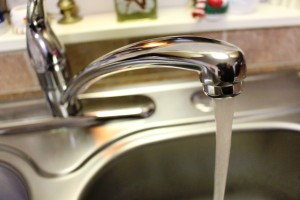
Water runs from the tap of a home on Front Street were lead levels of 428ppb were discovered in 2010. Photo by Lynn Rebuck/LititzDailyNews.com
“I’m concerned. Lead is certainly not good for you,” said Martin, who has lived in the home since 1990. Lead exposure can cause permanent neurological damage, and is known to be especially dangerous for pregnant women and children. In 1991, the EPA published a regulation to control lead and copper in drinking water. This regulation is known as the Lead and Copper Rule. In 1993, Lititz Borough was listed in an EPA report for failing to conduct required initial lead tap monitoring and reporting.
The rule also requires water suppliers to provide the results to anyone who has had their water tested. The Flint Drinking Water Task Force recommended that “when results are sent to residents, an explanation that the result does not represent lead exposure and that first draw samples have been found to underestimate lead levels in direct contact with a lead service line,” according to a document published by the EPA.
The Lititz Borough water system has lead service lines that connect homes to the water main, according to Lititz Borough manager Sue Barry.
Water providers must submit of a set number of water samples determined by the size of their distribution and previous lead test results. In 2010, Lititz Borough was required to provide 20 samples, and then calculate the level that 90 percent of homes tested were at or below. The borough was reportedly under the federal Action Level for 2010, so Severn Trent was not required to take corrective action to treat the water or notify residents of health consequences.
But a number of experts are concerned about whether water suppliers across the nation are “gaming the system,” when testing water samples for levels of lead and copper.
Among them is Yanna Lambrinidou, an adjunct assistant professor in Virginia Tech’s Department of Science and Technology Studies, and an associate of Marc Edwards, the researcher whose tests of Flint water uncovered levels far higher than the 11 ppb city officials told residents existed.
“Here are the two biggest problems with gaming: one is what homes are sampled, and the other one is how are they sampled,” said Lambrinidou in an interview Tuesday with LititzDailyNews.com. She explained that the EPA has had to issue general guidance as a result of some providers who gamed the system by taking multiple samples from a home and reporting only the lowest result.
“The monitoring program has to be done in a very specific way to be meaningful and to actually meet the requirements of the rule,” said Lambrinidou, who discussed with LititzDailyNews.com the importance of testing homes that are the highest risk for lead and using proper protocol to draw the samples.
Samples for lead are only to be drawn after a six-hour rest period for the pipes, and there should be no pre-flushing of the tap, she said.
Under regulations, suppliers use the required number of samples to determine what is called the 90th percentile level for lead by eliminating the top 10% of test results from the calculation.The calculation is not based on health risk.
“Lead and copper corrosion pose various health risks when ingested at any level,” according to the 2014 Pennsylvania Department of Environmental Protection Annual Compliance Report. The allowable limit for lead in drinking water is 15 parts per billion (pbb).
The discrepancy between the high lead level and what was reported to consumers has also drawn the attention of the United States EPA.
“Not meeting the content requirements (e.g., provide all required information) of the Federal Consumer Confidence Report Rule, is considered a violation,” wrote Roy Seneca, press officer for the US EPA to LititzDailyNews.
The Consumer Confidence Report rule requires water providers to accurately inform customers of test results for a variety of contaminants in drinking water, including lead.
“The information required to be included in the CCR differs by the type of contaminant sampled and how it is regulated. For lead and copper, the Federal regulation states in 40.C.F.R. §141.53(d)(4)(vi) ‘For lead and copper: the 90th percentile value of the most recent round of sampling and the number of sampling sites exceeding the action level,‘” wrote Seneca.
Federal and state law requires municipal water providers to inform customers via the CCR, or Annual Drinking Water Quality Report, if one sample of drinking water is above the federal limit for lead, even if the 90th percentile level does not reflect that result.
“For lead and copper, the Federal regulation states in 40.C.F.R. §141.53(d)(4)(vi) “For lead and copper: the 90th percentile value of the most recent round of sampling and the number of sampling sites exceeding the action level, wrote Roy Seneca, press officer for the US EPA to LititzDailyNews.com.
The statement received from Severn Trent focused on the 90th percentile results, but did not address its duty, and apparent failure, to report to consumers the number of sampling sites exceeding the action level.
“The exceedance of the action level is not a violation but may trigger additional requirements such as monitoring and public education. As set out below, the testing in 2007, 2010 and 2013 was under the action level at the 90th percentile. In fact, only one house had a level which exceeded the action level (0.428 mg/l in 2010).”
According to the US EPA, the state has oversight for reporting issues, but may choose to become involved.
“PADEP has primary responsibility to oversee implementation and enforcement of all regulations under the Safe Drinking Water Act, including determining violations and taking timely and appropriate enforcement actions,” wrote Seneca. “EPA maintains oversight and may take action if a primacy state fails to do so.”
Regulations require water suppliers to inform residents whose homes have been tested of the results. Those documents for the 2010 lead and copper testing have been requested by LititzDailyNews.com, along with other water records, but the borough claimed this week there will be a 30-day delay in providing them.
In the meantime, residents are concerned about lead levels in homes, apartments, and businesses in Lititz Borough. According to the EPA and CDC, there is no safe level of lead in drinking water.
Citizens who are concerned about the quality of Lititz Borough water may attend the monthly Lititz Borough Council meeting this Tuesday, February 23, at Lititz Borough Council Chambers, 7 S. Broad St., Lititz, Pa. 17543. The meeting is free and open to the public.
Register your email address to receive LititzDailyNews.com stories for free by clicking here. If you have concerns about your drinking water and want to have it tested, or if you have recently had your water tested for lead by the borough or an independent lab, email [email protected].

